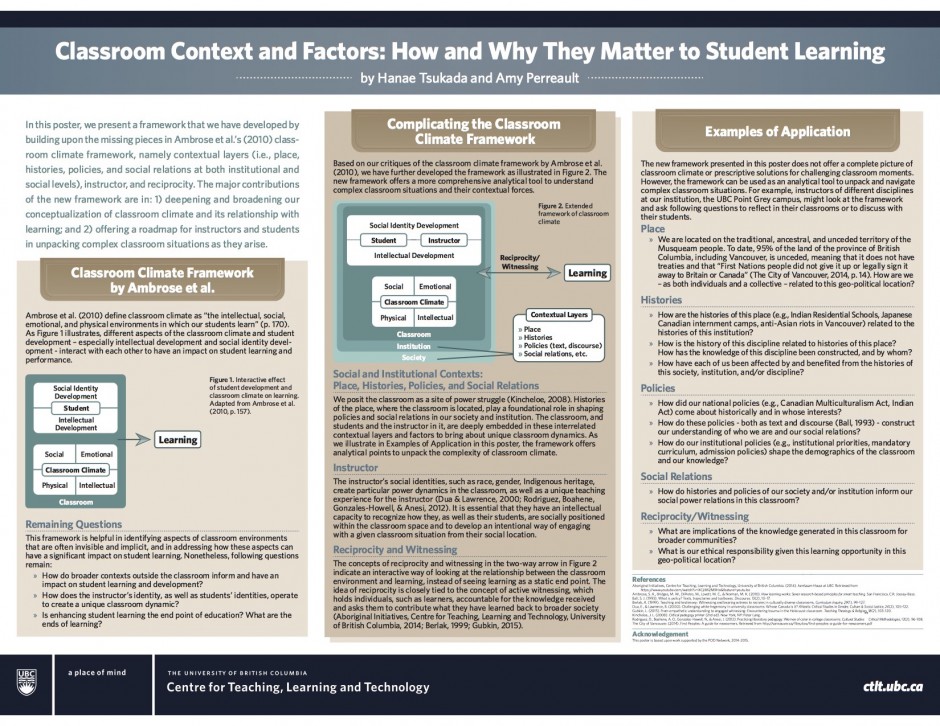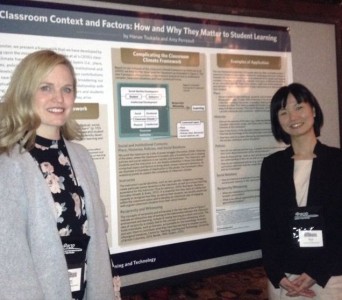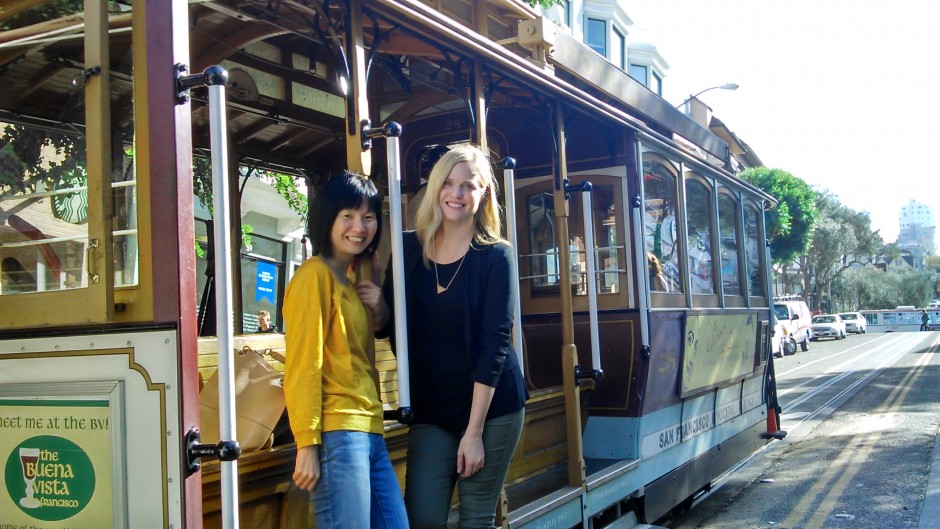
Tsukada and Perreault”s conference poster: “Classroom Contexts and Factors: How and Why They Matter to Student Learning”
Aboriginal Initiatives Strategist, Amy Perreault, and Classroom Climate and Educational Resource Developer, Hanae Tsukada recently returned from San Fransisco, California, where they shared their work on Classroom Climate at the Professional and Organizational Development (POD) Network in Higher Education conference, November 4-8, 2015. POD is a forty-year old, globally recognized professional organization serving faculty developers in higher education.
Hanae and Amy presented a poster titled “Classroom Contexts and Factors: How and Why They Matter to Student Learning,” and were awarded the 2015 Donald H. Wulff Travel Fellowship by the POD Diversity Committee in recognition of their work. Congrats!
We asked Hanae (HT) and Amy (AP) to reflect on and share from their experiences at the conference.
Describe one highlight from your experience at the conference.
The highlight of the conference was that, by becoming part of the POD Diversity Committee, I could be connected with colleagues who work in the field of equity and diversity at their education institutions. It was the first time for me to attend a POD conference, but the Diversity Committee instantly gave me “home” in a large conference like that.
—Hanae
AP The highlight for me was having a collective of colleagues that were engaged in issues of diversity at their own institutions and sharing what our challenges and ideas were. It is nice to have an opportunity to hear about the experiences of others doing this work in different locations around the world.
HT The highlight of the conference was that, by becoming part of the POD Diversity Committee, I could be connected with colleagues who work in the field of equity and diversity at their education institutions. It was the first time for me to attend a POD conference, but the Diversity Committee instantly gave me “home” in a large conference like that. As well as becoming part of a vibrant community like the Diversity Committee, Dr. Beverly Tatum serving as a plenary speaker for the conference gave me a sense of affirmation for my work in the field of teaching and learning in higher education.

Amy Perreault and Hanae Tsukada with POD Conference Colleagues, San Francisco, CA, USA (Nov 4-8, 2015); L-R Tsukada, Dr. Misiwe M. Katiya (Cape Peninsula University of Technology South Africa), Jacinta Mutambuki, Ph.D. STEM Education Postdoctoral Research Associate- Washington University in St. Louis), and Perreualt
What feedback did you receive on your “Classroom Contexts and Factors” poster session? How was your work received by Educational Developers coming at the work from different locations?
In our conversations with the Diversity Committee we could see that classroom climate was an emerging topic amongst our colleagues from institutions in the United States.
—Amy
Ironically, because recent incidences of race-related violence have been spurring such intense debate in many parts of the United States , it helped me engage many participants from the US in thinking about classroom climate in relation to what is happening there and the underpinning historical contexts in their own locations.
—Hanae
AP Many people stopped by our poster because they were familiar with the concept of classroom climate and student learning. In our conversations with the Diversity Committee we could see that classroom climate was an emerging topic amongst our colleagues from institutions in the United States. I do remember, in our roundtable of introductions, when Hanae introduced herself and her role, people were very impressed that UBC had created an Educational Developer position that focuses on Classroom Climate.
During the poster presentation, once we began to describe ways that we have adapted the model presented by Ambrose and colleagues from their book How Learning Works, conference participants began to reflect on their own institutional contexts. When we zeroed in on ways that our framework addresses and speaks to place, Indigenous histories, policies, social relations, etc., I think that this may have been a new conversation for some people, but they were genuinely interested in how we had developed and expanded on the model.
HT Ironically, because recent incidences of race-related violence have been spurring such intense debates in many parts of the United States, it helped me engage many participants from the United States in thinking about classroom climate in relation to what is happening there and the underpinning historical contexts in their own locations. I also met a few participants from my home country Japan, and my conversations with them made me think about some of the possibilities and challenges of discussing the complexities of social contexts of classroom climate in Japan, a country that has held the myth of homogeneity for a very long time.
What is one idea or take-away from a discussion that you are bringing back with you, and how are you planning to follow-up?
I was overjoyed to see Dr. Beverly Tatum as the keynote speaker since her work has informed the ways in which I have come to think about campus climate at UBC, especially for Indigenous students and students of colour . . . Reflecting on Beverly’s example we need to think of the full picture, the climate, the curriculum as well as having Indigenous faculty in the classrooms. This way students will be able to see themselves represented, and it will make it a more welcoming environment to learn in.
—Amy
AP I was overjoyed to see Dr. Beverly Tatum as the keynote speaker since her work has informed the ways in which I have come to think about campus climate at UBC, especially for Indigenous students and students of colour. I remember when I first started at CTLT, I came across her work and admired the bold ways in which she talked about race, identity and power. She often asks the question of her readers “Why do we not talk about these things in our classrooms?” and I also wondered how we could encourage faculty and others to bring these conversations into the learning that takes place here at UBC.
At the beginning of her talk, Dr. Tatum asked the audience to pretend that she was going to take a selfie with us. She stood up and proceeded to go through the motions of taking a selfie with the audience in the background. She asked the audience, “What is the first thing you would do?” She said, “You all would look to try to see yourself in the photo.” She then asked, “What would you do if your image was photoshopped out of the picture?” She concluded by saying that we all need affirmation by seeing ourselves represented in the spaces in which we operate. When we enter environments, we want to see ourselves in those environments, in the curriculum and in front of the class.
I feel that this is so important to consider here at UBC as well. As educators, facilitators, and others who work at the university, it is important to reflect on this; the impact is far too great not to. I get asked a lot how to increase the number of Indigenous students in Faculties and Departments at UBC. Reflecting on Dr. Tatum’s example, we need to think of the full picture, the climate, the curriculum, as well as having Indigenous faculty in the classrooms. This way students will be able to see themselves represented, and it will make for a more welcoming environment to learn in.
HT I particularly enjoyed a session on microagression and microresistance in the work context of Educational Developers like ourselves. Student microagressions in the classroom have been talked about relatively widely, and the primary focus of these conversations has been on how Instructors can respond to such classroom behaviours, or how Educational Developers can support Instructors to develop their capacities in this area. However, this conference session gave me a chance to think, “What about us, Educational Developers? Am I really able to resist microagressions that target my colleagues or myself?” The session introduced a four-step microresistance strategy we could use, and I would like to try integrating these strategies into my daily practice as well as into the resources and programs I develop. While doing so, as addressed in the session, I would also like to be attentive to concerns that microresistances could inadvertently benefit “allies” rather than the target and perpetuate the relations of power and oppression.
Were you able to enjoy the City? Share one image or memory of San Francisco that has nothing to do with the conference.
AP Yes we were able to sneak away to enjoy some of the city. Along with the amazing seafood, as a product of the 80’s, I was able to relive my Full House fantasy of riding the San Francisco streetcar. The hills are definitely no joke and Hanae and I took full advantage of this historic and entertaining mode of transportation.
HT While I loved riding the famous streetcars, I also appreciated a chance to walk on hills after enjoying great food, which helped us feel guilt-free and be ready for what to eat next!



